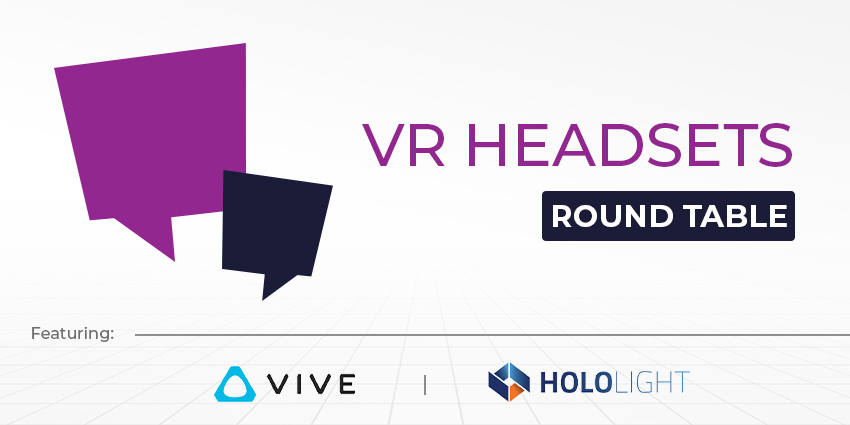The head-mounted display/headset marketplace may be approaching a broad shift as Apple unveils its Vision Pro headset next month, with the device promising to advance screen-based productivity into a third dimension, leveraging traditional MR technologies to achieve a spatial computing future.
Moreover, with the recent Quest 3 from Meta and XR Elite from HTC VIVE, the marketplace is adopting MR solutions within industry-wide product portfolios. However, the industry should not forget the importance of VR solutions and hardware.
VR headsets are at the heart of XR and spatial computing. Despite the rising trend of MR, which combines partial and fully immersive spatial applications, VR technology is powering this trend – alongside AR developments – to create the foundation for the future of wearable XR/spatial computing products for enterprise clients.
Speaking to XR Today are a pair of industry CEOs representing the VR headset space for enterprise clients, including:
- Thomas Dexmier, the AVP of Enterprise Solutions EMEA at HTC VIVE
- Susanne Haspinger, the COO & Co-founder of Hololight
Which industries, besides gaming, are adopting VR headsets the most, and how are they benefiting from the technology?
Thomas Dexmier
Enterprise XR had a very strong 2023 and is shaping up to have an even better 2024. Every industry, every vertical, every country is exploring XR and finding real use cases where they can benefit. It’s not so much the verticals, those specific industries which are driving adoption. It’s more in the horizontal, with things like training being revolutionized, for example.
Everything from medical and manufacturing, through to soft skills, is able to be reproduced in XR with accuracy and realism, and importantly with versatility as well – organizations are seeing big value gains in the way they can replay a wide range of scenarios without the need for a hyper-specialized set-up each time. Similarly, the nature of XR headsets means that the hardware can be taken anywhere easily; it’s even possible to set up a portable private 5G network, like GReigns.
I’m biased, but I think the most unexpected use case for XR in 2023 was VIVE Focus 3, making VR possible on the International Space Station. There were a lot of challenges to overcome, particularly with tracking. But we solved it, and now the ESA’s Andreas Mogensen is regularly using VR to help with mental health, with more to come!
Susanne Haspinger
Throughout 2024 and beyond, we’ll continue to see widespread adoption of VR headsets across verticals such as automotive, aerospace, manufacturing, mechanical engineering, and many more. VR will benefit any industry that produces complex assets and any industry that has use cases for remote collaboration design and visualization training or industrial processes surrounding product development.
Manufacturing will continue to make headlines when it comes to the innovation surrounding XR use cases. Competition is fierce in this market because many companies are creating similar things, so speed to market is critical. 3D is helping to accelerate prototype design and delivery, and because of this, manufacturers have made immersive technology integration a priority.
How can an enterprise client choose a VR headset that best suits their specific needs and budget?
Susanne Haspinger
Choosing a VR headset must start with the use case, as this will determine which headset can provide the best user experience. Think about using VR to optimize every day existing processes instead of inventing new ones or creating lighthouse projects.
VR works for big and small tasks and can be up and running in no time. You can start small and scale up. With the first VR process optimizations, your employees will come up with ideas for other processes as they better understand the capabilities of the technology.
Thomas Dexmier
As with all projects, it can be difficult knowing where to start. There’s a lot to consider, so we’re always open to having a broad discussion because we’ll be able to help identify important elements for different use cases. As well as which stakeholders need to be involved.
They need to consider several factors. Not just physical fit and specs but the deployment capabilities as well. Does the headset fit easily into an existing MDM? Does it meet your Legal team’s needs for privacy and security? Can IT easily manage updates?
Adopting any new technology needs time to see results; a pilot scheme or trial can be extremely powerful for demonstrating efficacy.
A great example is Amazon EU Customer Fulfilment’s trial of VR-based soft skills training for newly hired managers last year. They saw 95% positive feedback to the immersive training from participating employees during trial. After seeing this success, Amazon EU CF’s Learning and Development team plans to continue to develop training using VR and now has a proven blueprint for future implementations of immersive learning.
It’s also important to invest in an ecosystem that can evolve as needs grow – from advanced tracking and modular accessories to sensors that can help expand use cases and adoption.
Are there any best practices or emerging regulations for managing VR data and user experiences within businesses?
Thomas Dexmier
Absolutely, and VIVE is focused on a privacy-centric approach where we can make our clients lives better by designing to minimize data collection in the first place. A golden rule of thumb is to not collect more data than you need, and obviously, be aware of local data privacy regulations so you know how data must be handled and stored.
There are global standards to pay attention to – VIVE has ISO27001 and ISO27701 certifications, which help IT, Compliance, and Legal teams feel comfortable that there’s an extra level of security and data privacy involved. At VIVE, we’ve even gone to the lengths of adapting hardware for special requests from organizations in highly secure industries like defence, so there is no wireless connectivity, including Bluetooth.
When it comes to managing user experiences, it’s important that companies choose the right blend of devices and content to match objectives. XR should be an enabler to more effective outcomes, and the best way to achieve this is by identifying the specific problem you’d like to solve before you start. It’s also important to gather regular feedback from end-users about the XR tools they’re using to learn and improve – especially as and when your use cases grow.
Susanne Haspinge
Best practices for managing VR data usually come down to the security element provided by XR streaming, which is a big draw for all our enterprise customers. Running XR apps locally on mobile devices is a security risk as the data is not adequately protected and is exposed in case of loss or theft.
Companies are investing in XR streaming because it allows them to keep data off devices and within secure servers in their networks.
In 2024, aerospace and defence will continue to be at the forefront of capitalizing on immersive experiences with their unparalleled commitment to data security. These industries truly understand the critical role XR streaming can play in cybersecurity.
Will MR headsets overtake VR headsets in terms of adoption?
Susanne Haspinge
In the long term, MR headsets will overtake VR headsets because they will function as one device that can cover all use cases.
They will give end users the best of both worlds, covering both VR use cases and augmented reality use cases.
The Apple Vision Pro will pave the way for this progression, and over time, MR headsets will become the norm.
Thomas Dexmier
This past year we’ve seen the next generation of headsets emerging with both VR and MR capabilities. We even took a big leap forward ourselves by adding both VR and MR capabilities to our latest headset, the VIVE XR Elite. It makes sense to have a device which can do both. With that, the adoption of MR will inevitably continue to grow as the technology continues to advance and developers invest in creating MR-based applications.
However, we don’t believe that there should be a trade-off between MR or VR. In a B2B environment, the use of MR or VR is dependent upon the use case. There are scenarios where MR is most powerful and others where VR is most effective.
For example, if you’re a global product design team wanting to collaborate during prototyping, bringing 3D models into the real-world environment can help analyze and iterate designs on a 1:1 scale and in situ without having the create physical prototypes at a fraction of the time and cost.
VR However, for immersive soft skills training, having modules take place in a purely VR-based simulation removes background distractions and adds deeper immersion, which can deliver more effective learning outcomes.







